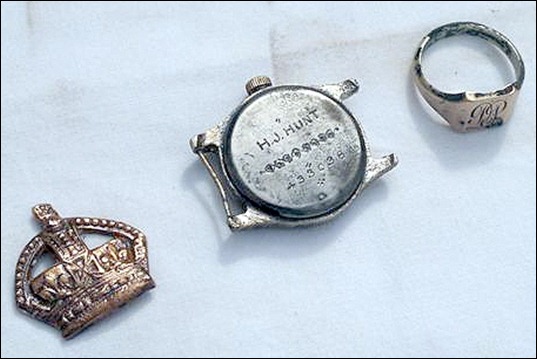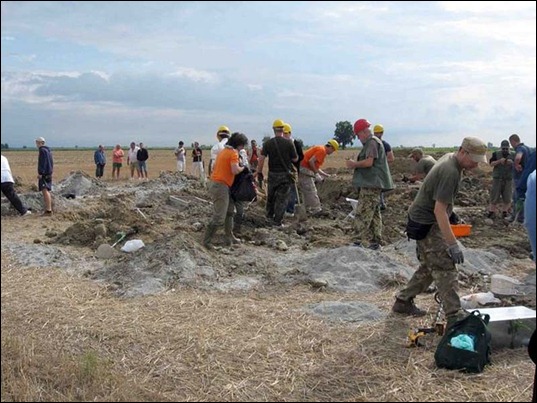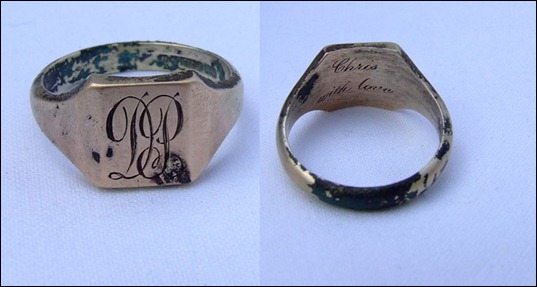Archeologi dell’aria Posted by Geoff on Jul 29, 2013 in Italian Language
I’ve always had an interest in the history of aviation and aviation archaeology, so I was particularly fascinated when I found a news item from 2011 about the recovery of a wrecked A-20 bomber and its crew, shot down by German anti-aircraft fire just days before the end of WWII in Italy. Here is an abbreviated version with my translation:
Questa è la storia di un aereo che dormiva sepolto sotto un campo di grano, nelle campagne di Copparo, pianura ferrarese a qualche tiro di schioppo dal Po. Una storia di guerra. A essere precisi, di quattro giorni prima che la guerra finisse. E di quattro ragazzi di cui non era rimasto che il nome, sul memoriale che, a Malta, ricorda i 2.298 aviatori del Commonwealth morti o dispersi nei cieli del Mediterraneo.
This is the story of an aircraft that slept beneath a corn field in the countryside near Copparo, which lies in the Ferrara plain just a stone’s throw away from the river Po. A war story. To be precise, from four days before the end of the war. And of four lads of whom nothing remained but names on a Maltese war memorial recording the 2,298 Commonwealth aviators who died or went missing in the Mediterranean skies.
 |
| Centre: The inscribed watch which lead to the identification of the four crew members |
Da allora, e fino a ieri mattina, di questa storia era saltato fuori solo un pezzo. Il motore destro dell’aereo. A guerra finita, Giordano Melchiori l’aveva portato via con il trattore. Se questa storia, seppellita sotto cinque metri di terra, è tornata alla luce del sole, è anche per merito suo. Oggi ha 82 anni, allora era solo un ragazzetto troppo giovane per la divisa. Ma se la ricorda ancora la notte del bombardiere tirato giù dalla contraerea tedesca. “Ho guardato in alto e ho visto l’aereo venire giù. S’è incendiato. Dicevano che, nel campo, ci fossero due corpi bruciati. Solo più tardi siamo andati a prenderci il motore. Sa, per via dell’alluminio. Dopo la guerra, lo compravano anche per farci le macchinette per tirare la sfoglia in casa”.
From then until yesterday morning (July 2011) only one piece of this story had been uncovered … the right hand motor of the plane. At the end of the war Giordano Melchiori carted it off with his tractor. And it’s thanks to him that this story, buried beneath five meters of soil, has come back to light. Today he is 82 years old, but back then he was just a lad too young to join the army. He still remembers it however, the night of the bomber shot down by a German anti aircraft battery. “I looked up high and I saw the aircraft come down. It burst into flames. They said that there were two burnt bodies in the field. It was only later that we went to get the motor. You know, because of the aluminium. After the war, they bought it, even using it to produce the little machines for making pasta at home.
Se l’era quasi dimenticato, Giordano, quell’aereo, finché un’amica, anche lei di Copparo, non gli aveva detto “Sai, Fabio, mio figlio, c’ha la passione di andare a ritrovare gli aerei caduti”. Fabio Raimondi è il webmaster del blog ‘Archeologi dell’aria’. Duecento cacciatori di «crash point», i punti dove si sono schiantati gli aerei di guerra. Ritrovano i relitti, consegnano i pezzi ai musei e i resti umani alle ambasciate, per farli avere ai parenti.
Giordano had almost forgotten the aircraft until a friend, also from Capparo, said to him “You know Fabio, my son, loves to go and discover crashed aircraft”. Fabio Raimondo is the webmaster of the blog Archeologi dell’aria. Two hundred ‘crash point’ hunters, who search for the places where planes crashed during the war. They find the relics and send pieces to museums, and human remains to the embassies, so that they can be returned to their relatives.
Dal campo di frumento è saltato fuori un orologio. Con un nome inciso, Hunt. È bastato quello per dare un nome ai quattro ragazzi morti sul Douglas A-20 Boston decollato da Forlì alle 20.45 del 21 aprile 1945 per bombardare un punto di attraversamento a Taglio di Po. John Penboss Hunt, l’australiano, era il mitragliere; Alexander Thomas Bostock l’operatore radio; David Millard Perkins il navigatore e David Kennedy Raikes (21 anni, uno in più dei suoi tre compagni di sventura), il pilota. E qui è arrivata la sorpresa. Perché quando il sergente Raikes non volava con un bombardiere, lo faceva con le parole. Era un poeta, nel suo piccolo, se volete, un Saint-Exupéry d’Oltremanica. E ha fatto in tempo a raccontarlo, come si senta un poeta dentro un uccello di metallo con un carico di morte nella pancia.
A watch was unearthed from the wheat field. On it was inscribed the name Hunt . It was sufficient to be able to identify the four lads who died in the A-20 Boston which had taken off from Forlì on the 21st of April 1945 to bomb a crossing point at Taglio di Po. John Penboss Hunt, the Australian, was the gunner; Alexander Thomas Bostock the radio operator; David Millard Perkins the navigator, and David Kennedy Raikes (21 years old, a year older than his three companions in misadventure), the pilot. And here was the surprise: when Sergeant Raikes wasn’t flying in a bomber, he did so with words. He was a poet, in his own way, if you like, a Saint-Exupéry from beyond the English Channel. And he had been able to recount they way that a poet feels inside a metal bird carrying a payload of death in its stomach.
 |
| Click on the photo above to watch a video of excavations |
The poems of David Raikes è la raccolta dei suoi versi, pubblicata postuma nel 1954. Forse ci voleva la sua penna per raccontare quel che si prova a trovare, come ieri mattina, un anello di fidanzamento sepolto da 66 anni: sopra, le iniziali del sergente Perkins. Dentro, una dedica: “Chris, with love”.
The Poems of David Raikes is a collection of his verses published posthumously in 1954. Perhaps you’d need his poetic pen to describe what it felt like to find, as happened yesterday morning, an engagement ring which had been buried for 66 years, with Sergeant Perkins initials inscribed on the top, and a dedication on the inside: “Chris with love”.
From an original article by Luca Angelini, 25 luglio 2011
 |
| Sergeant Perkins’ engagement ring, unearthed at the crash site |
On the 18th of July this year, two years after the excavation of the crash site, the four crew members were finally laid to rest at the Commonwealth War Graves cemetery in Padova.
It seems appropriate to end with an extract from one of David Raikes’ poems.
‘Let It Be Hushed’
These men knew moments you have never known,
Nor ever will; we knew those moments too,
And talked of them in whispers late at night;
Such confidence was born of danger shared.
We shared their targets, too; but we came back.
Lightly we talked of it. We packed their kit,
Divided up such common useful things
As cigarettes and chocolate, rations stored
Against a rainy day that never came.

Build vocabulary, practice pronunciation, and more with Transparent Language Online. Available anytime, anywhere, on any device.




Comments:
Joan:
Happy birthday to Serena. Well, it’s her birthday here in California, although it must be almost over in Italia.
William Auge:
Un altro ricordo della terribile costo della guerra, un prezzo che continuiamo a pagare.
Fabio:
Lest We Forget
Raymond Madge:
Many Thanks to Fabio and the team at Archeological dell’Aria. John Hunt was my Great Uncle and I was lucky enough to travel to Italy for the burial service. A once in a lifetime experience and all because of a dedicated team of Volunteers who give up their time to find WW2 plane crashes. I wish my Grandmother was still alive so she could have found out what happened to Uncle Johnny but I am sure that where ever she is, she is resting easier. Thanks again from Australia for finding our boys.